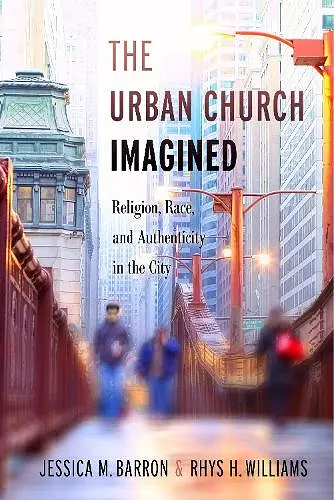The Urban Church Imagined
Religion, Race, and Authenticity in the City
Rhys H Williams author Jessica M Barron author
Format:Paperback
Publisher:New York University Press
Published:28th Nov '17
Currently unavailable, and unfortunately no date known when it will be back
This paperback is available in another edition too:
- Hardback£74.00(9781479877669)

Explores the role of race and consumer culture in attracting urban congregants to an evangelical church
The Urban Church Imagined illuminates the dynamics surrounding white urban evangelical congregations’ approaches to organizational vitality and diversifying membership. Many evangelical churches are moving to urban, downtown areas to build their congregations and attract younger, millennial members. The urban environment fosters two expectations. First, a deep familiarity and reverence for popular consumer culture, and second, the presence of racial diversity. Church leaders use these ideas when they imagine what a “city church” should look like, but they must balance that with what it actually takes to make this happen. In part, racial diversity is seen as key to urban churches presenting themselves as “in touch” and “authentic.” Yet, in an effort to seduce religious consumers, church leaders often and inadvertently end up reproducing racial and economic inequality, an unexpected contradiction to their goal of inclusivity.
Drawing on several years of research, Jessica M. Barron and Rhys H. Williams explore the cultural contours of one such church in downtown Chicago. They show that church leaders and congregants’ understandings of the connections between race, consumer culture, and the city is a motivating factor for many members who value interracial interactions as a part of their worship experience. But these explorations often unintentionally exclude members along racial and classed lines. Indeed, religious organizations’ efforts to engage urban environments and foster integrated congregations produce complex and dynamic relationships between their racially diverse memberships and the cultivation of a safe haven in which white, middle-class leaders can feel as though they are being a positive force in the fight for religious vitality and racial diversity.
The book adds to the growing constellation of studies on urban religious organizations, as well as emerging scholarship on intersectionality and congregational characteristics in American religious life. In so doing, it offers important insights into racially diverse congregations in urban areas, a growing trend among evangelical churches. This work is an important case study on the challenges faced by modern churches and urban institutions in general.
The authors demonstrate how the racialized urban imaginary affects the religious practices, organizations, and identity of this recently formed congregation, and the complex interactions among race, religion, class, gender, cultural consumption, and the city. The discussion revolves around the key concepts of racialized urban imaginary, managed diversity, and racial utility. A significant contribution to religion, race, and urban studies. * Choice *
In The Urban Church Imagined, Jessica M. Barron and Rhys H. Williams examine the 'dueling imaginations' posited by Downtown Churchs [DC] suburban-based leaders and city-based congregants as their new congregation negotiates racial, class, and gender boundaries. The depth and accessibility of this book make it an excellent read for scholars, students, and religious leaders interested in the sociology of religion, race theory, and/or the urban landscape. * Reading Religion *
The Urban Church Imagined offers a compelling insight on the organizational practices of white-led religious institutions as they attempt to interact with diversity … they offer a provocative salvo in furthering our understanding of the shallow adaptations of diversity and inclusion occurring in white evangelical organizations throughout the United States. In an era where racial coding and antagonism continue to resonate throughout social and political discourse, Barron and Williams have given good cause for further examination of the intersection of race, religion, and the city. -- American Journal of Sociology
This book serves as a useful guide for how churches may approach attracting new members in a period of increasing racial diversity and declining worship attendance. -- Review of Religious Research
The Urban Church Imagined sheds light on this problematic dichotomy of the desire to reach the urban population and to be relevant in the racially diverse context of urban areas on the one hand, and the implicit racism, sexism, and classism undergirding their history on the other hand … The critical perspective offered in the book has a massive potential as a working tool for professionals involved in urban ministry, both lay and ordained … Overall, The Urban Church Imagined is a practical, insightful, and well written exploration of the challenges of social aspects in urban ministry that carries massive potential for the modern church as a whole, both the urban and the rural, both the diverse and the homogeneous. -- Anglican Theological Review
The City Imagined expertly takes us into the heart of 'new urban' Christianity, a Christianity reflecting a renewed interest in the city, but a city highly constructed to serve idealized purposes. With richness of analysis and deep insight, we learn about the very heart of new America--thegood, the bad, and the ugly. A fascinating read. -- Michael O. Emerson,Provost and Professor, North Park University and author of Blacks and Whites in Christian America
Ambitious evangelicals want to reach the citya dynamic place filled with connotations of fashion, power, and cosmopolitanism. But the desire of evangelical churches to be relevant and racially diverse is colliding with the implicit racism still underlying their history. Drawing from observations in a multiracial evangelical church in downtown Chicago, The Urban Church Imagined reveals how modern evangelicalism is deeply entangled in the desire for contemporary relevance while persisting in racial prejudices and outright discrimination. -- Gerardo Marti,author of A Mosaic of Believers: Diversity and Innovation in a Multiethnic Church
ISBN: 9781479887101
Dimensions: unknown
Weight: 327g
240 pages